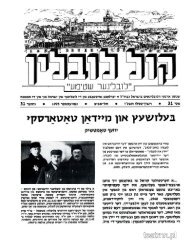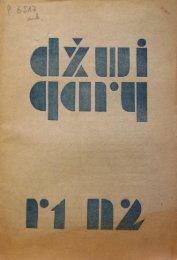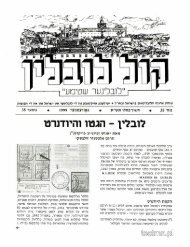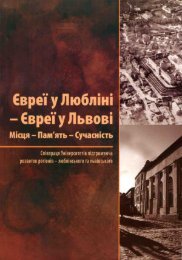The Jews in Lublin - Biblioteka Multimedialna Teatrnn.pl - Brama ...
The Jews in Lublin - Biblioteka Multimedialna Teatrnn.pl - Brama ...
The Jews in Lublin - Biblioteka Multimedialna Teatrnn.pl - Brama ...
Create successful ePaper yourself
Turn your PDF publications into a flip-book with our unique Google optimized e-Paper software.
Valley, where some executions were held 13 . Yet, there is no official permission for local<br />
and regional Lviv authorities to erect a monument 14 .<br />
In Lubl<strong>in</strong> <strong>in</strong> 1962, on the <strong>in</strong>itiative of the Jewish survivors, a monument was established<br />
commemorat<strong>in</strong>g the Lubl<strong>in</strong> and Lubl<strong>in</strong> region <strong>Jews</strong> murdered dur<strong>in</strong>g the Nazi<br />
occupation, however, its secluded location (between Świętoduska St. and Lubartowska<br />
St.) proves the then authorities were lean<strong>in</strong>g towards belittl<strong>in</strong>g this problematic subject.<br />
A permit was not granted for a location <strong>in</strong> the present day Castle Square (<strong>in</strong> 1962 Peo<strong>pl</strong>es<br />
Gather<strong>in</strong>g Square), which had been the heart of the ghetto, because it served as the venue<br />
for communist festivals and the monument would purportedly have been excessively<br />
exhibited. Orig<strong>in</strong>ally, the city authorities <strong>in</strong>tended to <strong>pl</strong>ace the memorial among the Old<br />
Town tenement build<strong>in</strong>gs, <strong>in</strong> a little square at the junction of Rybna St. and Noworybna<br />
St. Yet, as a consequence of long negotiations the monument found its <strong>pl</strong>ace <strong>in</strong> its present<br />
location 15 . <strong>The</strong> exterm<strong>in</strong>ation of <strong>Jews</strong> was not shown or <strong>in</strong>corporated <strong>in</strong> the ideas of<br />
<strong>in</strong>ternational character, of the victimization, as it was <strong>in</strong> the case with the Auschwitz and<br />
Majdanek concentration camps or even the Sobibor exterm<strong>in</strong>ation camp.<br />
After 1968 Jewish issues <strong>in</strong> Poland were totally supressed. In the USSR this lasted<br />
even longer - until the 1980's, by which time Poland had already started discussions<br />
on the role of <strong>Jews</strong> <strong>in</strong> the Polish historical consciousness, and the first commemoration<br />
attempts were undertaken. In both countries, however, the surviv<strong>in</strong>g historical build<strong>in</strong>gs<br />
and monuments still suffered devastation 16 .<br />
13 Until 2005 this area was the location of a police kennel. In 2006 the Police moved elsewhere but the<br />
area rema<strong>in</strong>s squalid and the kennel build<strong>in</strong>gs are decrepit. <strong>The</strong> authors observations from a Lviv trip<br />
<strong>in</strong> 2005 and 2006.<br />
14 <strong>The</strong> most known Ukra<strong>in</strong>ian site related to Holocaust, which was affected by the Soviet oblivion'<br />
policy, is Babi Jar <strong>in</strong> Kiev; <strong>in</strong> September 1941 the Germans murdered over 30,000 Kiev <strong>Jews</strong> there.<br />
This <strong>pl</strong>ace had no monument for many years. <strong>The</strong> site was com<strong>pl</strong>etely rebuilt and does not resemble<br />
the orig<strong>in</strong>al Babi Jar today. <strong>The</strong> nearby Jewish cemetery, where those executed were collected, was<br />
totally devastated <strong>in</strong> the 1960s. Babi Jar was prohibited from be<strong>in</strong>g spoken about. It was not until the<br />
1990s when the site was partially returned its correct <strong>pl</strong>ace <strong>in</strong> remembrance.<br />
15 Presently, (s<strong>in</strong>ce 2006) there is a construction of multi-level underground park<strong>in</strong>g garage, thus the<br />
monument was temporarily moved to the vic<strong>in</strong>ity of the pre-war Jewish female school (currently, Primary<br />
School 24) at 1 Niecała Street. On the location obstacles, see the unpublished author's <strong>in</strong>terview<br />
with Izydor Sznajdman (August 2000).<br />
16 An exam<strong>pl</strong>e of such devastation is the new Jewish cemetery <strong>in</strong> Kołomyja, Ivano-Frankivsk District<br />
(former Stanisławów Prov<strong>in</strong>ce). In the second half of the 1980s the local authorities decided to have<br />
this graveyard com<strong>pl</strong>etely demolished. <strong>The</strong> gravestones were shovelled by a bulldozer and cast <strong>in</strong>to the<br />
river, and the graveyard turned <strong>in</strong>to a square and football pitch. Only part of the wall survived with visible<br />
bullet marks on it - the cemetery was an execution site for <strong>Jews</strong>, but also for Poles and Ukra<strong>in</strong>ians<br />
who helped them. Until now, no memorial <strong>pl</strong>aque has been <strong>in</strong>stalled. <strong>The</strong> <strong>in</strong>formation comes from the<br />
author's own observations <strong>in</strong> Kołomyja <strong>in</strong> 2006 and the <strong>in</strong>terview with Borys Bojko an <strong>in</strong>habitant of<br />
Kołomyja.<br />
68

















